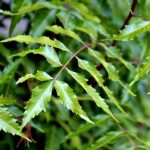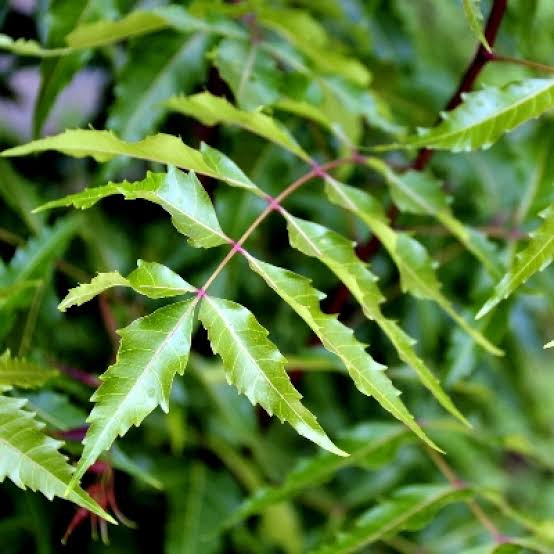Azadirachta indica or Neem or Dogon yaro (Hausa) or Igi-oba (Yoruba) or Nchanwu (Igbo): Tree as a big and potent drug store.
Neem is an omnipotent tree and a sacred gift of nature. Neem tree is mainly cultivated in the Indian subcontinent and is a member of the mahogany family called Meliaceae. Nowadays, it is known botanically as Azadirachta indica (A. indica) A. Juss. Neem has been used extensively by humankind to treat various ailments before the availability of written records which recorded the beginning of history. Since prehistoric times, neem has been used by humankind. The Latinised name of neem – Azadirachta indica is derived from the Persian. Azad means “free”; dirakht stands for “tree”, while indica symbolizes its “Indian origin”. For this reason, it literally means “the free tree of India”. Dogon yaro grows in much of south East Asia and West Africa, and more recently Caribbean and south and Central America. The neem tree is an incredible plant that has been declared the “Tree of the 21st century” by the United Nations.
The US National Academy of Science published a report in 1992 entitled “Neem: A tree for solving global problems”. Several biologically active substances have been isolated from different parts of the neem tree, including azadirachtin, meliacin (forms the bitter components of neem oil), gedunin, nimbidin, nimbolides, salanin, nimbin, valassin. The seeds also contain tignic acid, which is responsible for the distinctive odour of the oil. Neem kernels contain 30-50 % of oil mainly used by the soap, pesticide and pharmaceutical industries and contain many active ingredients, which are together called triterpenoids or limonoids.
The four best limonoids compounds are: Azadirachtin, Salannin, Meliantriol, and Nimbin. Limonoids contain insecticidal and pesticidal activity. All parts of the tree have been used medicinally for centuries. It has been used in Ayurvedic medicine for more than 4000 years due to its medicinal properties. The earliest Sanskrit medical writings refer to the benefits of neem’s fruits, seeds, oil, leaves, roots and bark.
Each has been used in the Indian Ayurvedic and Unani medicine, and is now being used in pharmaceutical and cosmetics industries. The sanskrit name of the neem tree is ‘Arishtha’ meaning ‘reliever of sickness’ and hence is considered as ‘Sarbaroganibarini’. The tree is still regarded as ‘village dispensary’ in India. As indicated earlier, various parts of the neem tree have been used as traditional Ayurvedic medicine in India from time immemorial.
Neem leaves are useful for the treatment of chickenpox, increasing immunity of the body, reducing fever caused by malaria, treating various foot fungi, useful against termites and for curing neuromuscular pains. The medicinal utilities have been described, especially for leaf, fruit and bark. Neem bark and roots control fleas and ticks on pets, fights against skin infections such as acne, psoriasis, scabies, eczema, etc, treats diabetes, AIDS, cancer, heart disease, herpes, allergies, ulcers, hepatitis and several other diseases. Neem oil and the bark and leaf extracts have been therapeutically used as folk medicine to control leprosy, intestinal helminthiasis, respiratory disorders, constipation and also as a general health promoter. Its use for the treatment of rheumatism, chronic syphilitic sores and indolent ulcer has also been demonstrated scientifically.
Neem oil can be used to control various skin infections. Bark, leaf, root, flower and fruit together can be used for the management of hematological (blood) disorders, biliary afflictions, itching, skin ulcers, and burning sensations.
Neem seed and leaf extracts are effective against malarial parasites. Components of the alcoholic extracts of leaves and seeds are effective against both chloroquin-resistant and sensitive strains of malarial parasite. Oil from the leaves, seeds and bark possesses a wide spectrum of antibacterial action against Gram-negative and Gram-positive microorganisms, including Streptococcus mutans, that is, the main bacteria responsible for the development of dental caries (tooth decay).
No wonder, when I was a child, I used to see the elderly population cleaning their teeth with fresh sticks of the neem tree. There are many therapeutic uses of the neem plant. Hot water extract of the bark is taken orally by the adult female as a tonic and emmenagouge (stimulation of blood flow). Anthraquinone fraction of dried flower, fruit and leaf is taken orally for leprosy. Hot water extract of the flower and leaf is taken orally as an anti-hysteric remedy, and used externally to treat wound. The dried flower is taken orally for diabetes. Hot water extract of dried fruit is used for piles and externally for skin disease and ulcers. Hot water extract of the entire plant is used as anthelmintic, an insecticide and purgative. Juices of bark of Andrographic puniculata, Azardiracta indica, Tinospora cardifolia, are taken orally as a treatment for filariasis (parasitic disease caused by roundworm). The hot water extract is also taken for fever, diabetes, and as a tonic, refrigerant, anthelmintic. Fruit leaf and root, ground and mixed with dried ginger and ‘Triphala” is taken orally with lukewarm water to treat common fever.

Credit: Plantsguru
Leaves due to insecticidal properties are kept with woollen and other cloths for long time. Leaf juice is given in gonorrhoea and leucorrhoea. Leaves applied as poultice to relieve boils, their infusion is used as antiseptic wash to promote the healing of wound and ulcers. A paste of leaves is used to treat wounds, ring worms, eczema and ulcers. Bathing with neem leaves is beneficial for itching and other skin diseases. Leaf juice is used as nasal drop to treat worm infestation in nose. Steam inhalation of bark is useful in inflammation of throat. Decoction can cure intermittent fever, general debility convalescent, and loss of appetite after fever. Infusion of flower is given in dyspepsia and general debility. The tender twigs of the tree are used as tooth brush which is believed to keep the body system healthy, the breath and mouth clean and sweet. Seed oil is used in leprosy, syphilis, eczema, chronic ulcer.
And one other thing……………Possible sidd-effects of Neem (Dogon yaro)?
In response to queries from some of my readers about the safety of the use of the neem, I have drafted a few notes on this issue, based on the expertise of the American Academy of Sciences. Cautioned must be exercise when using Neem preparations to young children. This is because the results of some scientific investigations indicate that the use of neem oil as a general cure-all for children is a most unwise practice, at least among the very young. When children under the age of four were given doses (5-30 ml) of neem oil, they came down with a disease similar to Reye’s syndrome. This severe disorder involves swelling of the brain, liver, and other organs. Both Reye’s syndrome and its neem-oil-induced mimic are poorly understood. Nonetheless, the message is clear: neem oil and neem extracts should be carefully used for internal medicinal purposes until more thoroughly tested. There are also anecdotal accounts from West Africa of neem-leaf teas possibly causing kidney damage when taken over a long period. In other studies, neem extracts were found to be toxic to guinea pigs and rabbits and leaves fed to goats and guinea pigs (50-200 mg per kg body weight) reduced their rate of growth. The ultimate significance of these preliminary studies is unclear. The materials used may well have been contaminated – perhaps by fungal toxins. Other trials have found no toxicity problem. For instance, in a toxicological study in Germany, neem oil obtained from clean, fungus-free seed kernels showed no oral toxicity in rats.
The dosage tested was 5,000 mg per kg body weight. Certainly, no hazard has been observed when neem has been used in topical treatments (on skin complaints, for example) or in dental uses, which together make up by far the major medical applications. Nor is there any evidence that using the seed-kernel extracts as pesticides is hazardous to health.
These are the thoughts of:
Sa’eed Halilu Bawa
Senior Lecturer (Associate Professor) at University of the West Indies, St. Augustine Campus, Trinidad.
Studied Food and Nutrition Sciences, Dietetics at Kaduna Polytechnic, Nigeria; Warsaw University of Life Sciences, Poland.
























